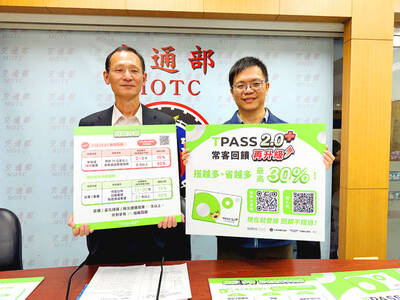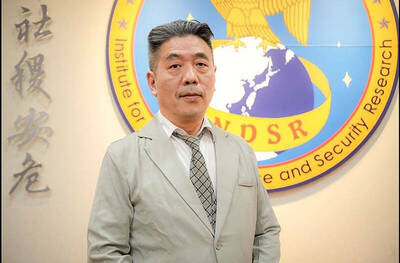Liberty Times (LT): The National Communications Commission (NCC) has required the nation’s TV stations to broadcast at least 70 percent original programming, with heavy penalties for non-compliance. The measure has prompted Chinese Television System (CTS) to change the way it produces its programs. Can you clarify the NCC’s objective?
Nicole Chan (詹婷怡): CTS’ problem is rooted in the fact that the station went many years without producing its own programs, so there was not even old content for them to draw on for reruns. Looking at CTS, you can see how the NCC hopes to revitalize the local film and television industry. For at least 10 years, there has been a sharp decline in traditional advertising and viewer habits have changed. Investors are less motivated, which hampered stations’ ability to produce content.
Taiwan does not lack talented people, but the lack of opportunities here means they need to find alternative paths for career development.

Photo: Liu Hsin-de, Taipei Times
After analyzing the nation’s capabilities in creating original film and TV content, we decided that quantity should first be increased and quality later.
If we set production standards too high we will end up with too much inferior content, but if we do nothing then we will face a brain drain, which is even worse.
Creative industries are the voices of every nation — we cannot apply the same standards we use for other industries. Maybe they will not produce an astonishing amount of content, but if opportunities for development are there, will we see talent emerge, and then broadcasters will be able to attract more investment. The government must understand this point to solve the problem.
LT: Will the NCC reacquire underutilized wireless digital frequencies from TV broadcasters and reassign them or auction them off?
Chan: That is the international practice and we have not ruled out the possibility, but we have not made a decision on the issue.
There is a group at the NCC tasked with the handling of wireless frequencies used by the TV industry that has met several times since its establishment in August last year. It is examining the efficiency with which the stations are using wireless frequencies and looking for ways to help them improve their efficiency and broadcast quality.
Part of the process is asking whether the point has been reached where improvement cannot be made and the frequencies should be reacquired.
The US uses a system of incentive auctions to buy back unused portions of the wireless frequency spectrum from TV operators. We have kept a close eye on this trend, because wireless frequencies are public property and leaving them unused is a waste.
Making room for lower frequencies can improve coverage on wireless broadband networks. There are 22 stations available for wireless TV, but the use of and investment in them are still inadequate, and building new transmission stations relies on government funds. We are concerned about wireless television and will reach a final verdict on it this year.
LT: What is the NCC’s stance regarding the market’s move away from traditional broadcast technologies, such as over-the-air and cable TV, and toward IP-based systems?
Chan: TV operators used to close their doors, only wanting to compete with their neighbors. The emergence of the digital age forced a change in competitive postures. People in all industries are expanding beyond their traditional boundaries, like wolves and tigers moving into new territory and covetously eying their prey. TV stations are now facing competition from IPTV and “over the top” systems, which bring numerous possibilities to the industry.
Competitiveness in the industry will be determined by content and services. Those who sit by idly or waste time producing inferior content will only be rushing toward the inevitability of their subscribers cutting the cord.
The NCC’s attitude is one of competition with the new systems, cooperation and openness. This is the basic core concept behind the Internet. The more industry operators open up and cooperate, the more opportunities there will be. Differences should be maintained, just as before, but the Digital Convergence Act (數位匯流法) pivots on sharing and cooperation. We hope to create a mutually beneficial ecology, because — as everyone in the industry should have realized by now — the industry has already undergone tremendous changes.
LT: If not for this year’s Summer Universiade, the government would not have ordered the provision of fourth-generation (4G) mobile services and 100Mbps Wi-Fi connectivity along the high-speed rail network. Do you think Taiwan’s broadband infrastructure is being developed too slowly?
Chan: [Development of] basic broadband infrastructure is an important job of the NCC. The rate of 4G network penetration in Taiwan is extremely high and basic equipment allocation is complete. We rank high on the global scale — we only need to pick up the pace in implementing relevant laws and the network will be even more complete.
We have acquired additional funding through the Forward-Looking Infrastructure Development Program that we will use to upgrade rural communities from a 20Mbps broadband network to a 100Mbps one.
This is the last stretch of broadband infrastructure development.
What Taiwan needs to address is bringing services up to speed. Who would sign up for services or buy new mobile devices if there are no services available or which interest them? There is a lot of potential for development by integrating broadband with other services like long-term care and education. All it takes is for people to come up with ideas and the infrastructure can be built to accommodate them.
The NCC also has a group working on the establishment of a 5G network. Taiwan is not moving slowly — some of the standards have not been defined yet. South Korea and the US are still working out the details of a standard for 5G mobile networks. They expect to have a standard in place by 2020 at the earliest.
The biggest change that 5G will bring is the integration of the Internet of Things. Our businesses and daily lives will see huge changes. The technology, industries and societies of the future will all change as a result. Some jobs will disappear, but there will be some new skills that will come into demand as well.
LT: The public is concerned about network quality. Taiwan’s 4G network is supposed to be an “information superhighway,” but users often face signal problems.
Chan: Indeed that is the case. We have already entered the 4G era, but when we go into the mountains, it becomes 3G. That is because the range of ground installations is still insufficient. We need to promote the continued development of hardware infrastructure while taking measurements of mobile communications signals. Basically, we need to report on the performance of the different mobile communications service providers.
However, the accuracy of the measurements will depend on the methodology used, the time when the measurements are taken and the location where they are taken. To prevent the measurement results from being used as a marketing tool by companies, we will draw from a wide variety of measurement sources and let customers decide what service provider best suits their needs. Measurement results will be announced in the summer and will hopefully compel companies to improve the quality of their services.
Translated by staff writer William Hetherington

Taipei and Kaohsiung have extended an open invitation to Japanese pop star Ayumi Hamasaki after Chinese authorities abruptly canceled her scheduled concert in Shanghai. Hamasaki, 47, had been slated to perform on Saturday before organizers pulled the show at the last minute, citing “force majeure,” a move widely viewed as retaliation for Japanese Prime Minister Sanae Takaichi’s recent remark that a Chinese attack on Taiwan could draw a military response from Tokyo. Taipei Mayor Chiang Wan-an (蔣萬安) yesterday said the city “very much welcomes” Hamasaki’s return and would continue to “surprise” her. Hamasaki, who has a large global fan base, including

Starting next month, people who signed up for the TPass 2.0 program can receive a 15 percent rebate for trips on mid to long-distance freeway buses or on buses headed to the east coast twice every month, the Highway Bureau said. Bureau Director-General Lin Fu-shan (林福山) said the government started TPass 2.0 to offer rebates to frequent riders of public transportation, or people who use city buses, highway buses, trains or MRTs at least 11 times per month. As of Nov. 12, 265,000 people have registered for TPass 2.0, and about 16.56 million trips between February and September qualified for

The year 2027 is regarded as the year China would likely gain the capability to invade Taiwan, not the year it would launch an invasion, Taiwanese defense experts said yesterday. The experts made the remarks after President William Lai (賴清德) told a news conference on Wednesday that his administration would introduce a NT$1.25 trillion (US$39.8 billion) special defense budget bill to boost Taiwan’s overall defense posture over the next eight years. Lai said that Beijing aims for military unification of Taiwan by 2027. The Presidential Office later clarified that what Lai meant was that China’s goal is to “prepare for military unification

‘REGRETTABLE’: Travelers reported that Seoul’s online arrival card system lists Taiwan as ‘China (Taiwan),’ the Ministry of Foreign Affairs said The Ministry of Foreign Affairs yesterday urged South Korea to correct the way Taiwan is listed in its newly launched e-Arrival card system, saying the current designation downgrades the nation’s status. South Korea rolled out the online system on Feb. 24 to gradually replace paper arrival cards, which it plans to phase out by next year. Travelers must complete the electronic form up to 72 hours before entering the country. The ministry said it has received multiple complaints from Taiwanese travelers saying that the system lists Taiwan as “China (Taiwan)” in dropdown menus for both “place of departure” and “next